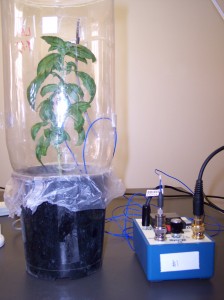I covered over 5,000 miles in California searching and scouting for appropriate habitat that would lead me to populations of blue-green sharpshooters. That’s six and a half times the length of the state! These insects prefer riparian areas that have high humidity, shade, and plenty of host plants such as blackberries, mugwort, and wild grape. I pulled out old fashioned maps and looked for the blue lines that indicate creeks, rivers, and streams. Being in California however, these supposed waterways weren’t always wet. I also relied heavily on Google Earth as it gave me a clearer picture of what these streams looked like and whether or not they had greenery surrounding them.
I made a slow spiral out from the Inland Empire into the rest of the state. I relied heavily on the help of other scientists, land owners, and park employees for leads on new collecting sites and for the generously letting me tramp through their land. I had many people spend the day driving around with me scouting out sites and it made a welcome change from the days and weeks spent collecting alone.
One of my best site discoveries was made while wandering around a small park in Northern California. A family having a picnic asked what I was doing and when I explained what I was looking for they told me of an obscure plot of land with a stream bordered by blackberry and grape plants. “Go over the bridge, past the county dump and down the dirt road. You can’t miss it.” I would have missed it never knowing how close I was to one the best sharpshooter populations in the state if it wasn’t for them. This site became a major factor in my research as it was the most northerly site I found.
Most of my days went like this: wake up at dawn, load the car up, drive around and stop at any place that looks like it could possibly have habitat for my insects, sweep net and aspirate as many bugs as I can, drive until dark, find a hotel and process the insect samples I collected during the day. I stopped at every creek, river, pond, lake and ocean park I could find. Sometimes I turned on streets with promising key words like “Mill Creek” or “River Road” in the hopes these streets really did border waterways. I learned that often street names have no bearing on their actual location, but sometimes I got lucky. I collected on the Mexican border with the border patrol circling overhead in the most depressing park I had ever been. I drove through massive forest fires in Northern California trying to get to sites before they burned down or were covered in ash, (it felt eerie being the only car to drive towards the fires, and I often had to change my route as roads closed down).
I met lots of interesting people, saw most of the state of California and spent loads of time outdoors. I loved every minute of it.
Setting up a field recording at my northern site.
| From French Gulch |
Here’s my husband collecting.
| From French Gulch |

